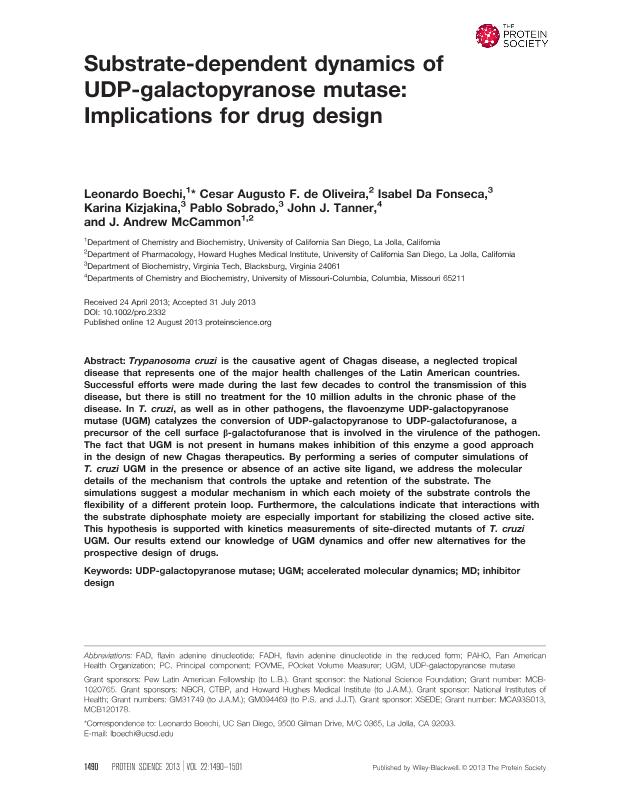Mostrar el registro sencillo del ítem
dc.contributor.author
Boechi, Leonardo

dc.contributor.author
de Oliveira, César Augusto F.
dc.contributor.author
Da Fonseca, Isabel
dc.contributor.author
Kizjakina, Karina
dc.contributor.author
Sobrado, Pablo
dc.contributor.author
Tanner, John J.
dc.contributor.author
McCammon, J. Andrew
dc.date.available
2017-05-02T19:21:27Z
dc.date.issued
2013-11
dc.identifier.citation
Boechi, Leonardo; de Oliveira, César Augusto F.; Da Fonseca, Isabel; Kizjakina, Karina; Sobrado, Pablo; et al.; Substrate-dependent dynamics of UDP-galactopyranose mutase: implications for drug design; Wiley; Protein Science; 22; 11; 11-2013; 1490-1501
dc.identifier.issn
0961-8368
dc.identifier.uri
http://hdl.handle.net/11336/15880
dc.description.abstract
Trypanosoma cruzi is the causative agent of Chagas disease, a neglected tropical disease that represents one of the major health challenges of the Latin American countries. Successful efforts were made during the last few decades to control the transmission of this disease, but there is still no treatment for the 10 million adults in the chronic phase of the disease. In T. cruzi, as well as in other pathogens, the flavoenzyme UDP-galactopyranose mutase (UGM) catalyzes the conversion of UDP-galactopyranose to UDP-galactofuranose, a precursor of the cell surface β-galactofuranose that is involved in the virulence of the pathogen. The fact that UGM is not present in humans makes inhibition of this enzyme a good approach in the design of new Chagas therapeutics. By performing a series of computer simulations of T. cruzi UGM in the presence or absence of an active site ligand, we address the molecular details of the mechanism that controls the uptake and retention of the substrate. The simulations suggest a modular mechanism in which each moiety of the substrate controls the flexibility of a different protein loop. Furthermore, the calculations indicate that interactions with the substrate diphosphate moiety are especially important for stabilizing the closed active site. This hypothesis is supported with kinetics measurements of site-directed mutants of T. cruzi UGM. Our results extend our knowledge of UGM dynamics and offer new alternatives for the prospective design of drugs.
dc.format
application/pdf
dc.language.iso
eng
dc.publisher
Wiley

dc.rights
info:eu-repo/semantics/openAccess
dc.rights.uri
https://creativecommons.org/licenses/by-nc-sa/2.5/ar/
dc.subject
Udp-Galactopyranose Mutase
dc.subject
Ugm
dc.subject
Molecular Dynamics
dc.subject
Accelerated Molecular Dynamics
dc.subject.classification
Físico-Química, Ciencia de los Polímeros, Electroquímica

dc.subject.classification
Ciencias Químicas

dc.subject.classification
CIENCIAS NATURALES Y EXACTAS

dc.title
Substrate-dependent dynamics of UDP-galactopyranose mutase: implications for drug design
dc.type
info:eu-repo/semantics/article
dc.type
info:ar-repo/semantics/artículo
dc.type
info:eu-repo/semantics/publishedVersion
dc.date.updated
2017-04-28T20:29:17Z
dc.journal.volume
22
dc.journal.number
11
dc.journal.pagination
1490-1501
dc.journal.pais
Estados Unidos

dc.journal.ciudad
Hoboken
dc.description.fil
Fil: Boechi, Leonardo. University Of California At San Diego; Estados Unidos
dc.description.fil
Fil: de Oliveira, César Augusto F.. University Of California At San Diego; Estados Unidos
dc.description.fil
Fil: Da Fonseca, Isabel. Virginia Tech University; Estados Unidos
dc.description.fil
Fil: Kizjakina, Karina. Virginia Tech University; Estados Unidos
dc.description.fil
Fil: Sobrado, Pablo. Virginia Tech University; Estados Unidos
dc.description.fil
Fil: Tanner, John J.. University Of Missouri; Estados Unidos
dc.description.fil
Fil: McCammon, J. Andrew. University Of California At San Diego; Estados Unidos
dc.journal.title
Protein Science

dc.relation.alternativeid
info:eu-repo/semantics/altIdentifier/doi/http://dx.doi.org/10.1002/pro.2332
dc.relation.alternativeid
info:eu-repo/semantics/altIdentifier/url/http://onlinelibrary.wiley.com/doi/10.1002/pro.2332/abstract
Archivos asociados
